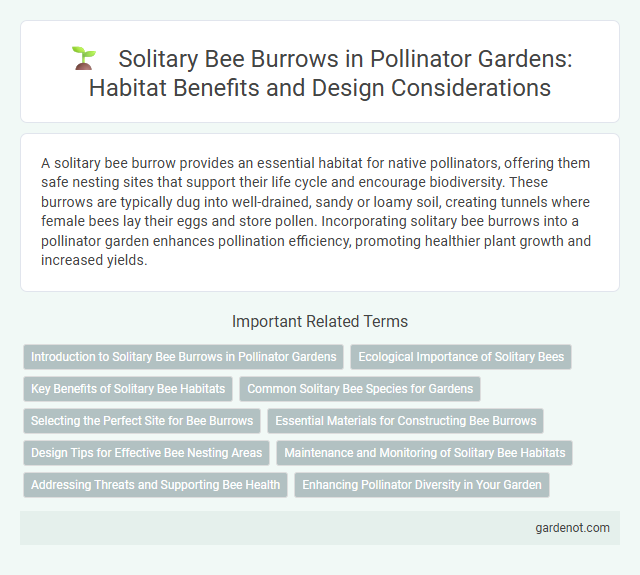A solitary bee burrow provides an essential habitat for native pollinators, offering them safe nesting sites that support their life cycle and encourage biodiversity. These burrows are typically dug into well-drained, sandy or loamy soil, creating tunnels where female bees lay their eggs and store pollen. Incorporating solitary bee burrows into a pollinator garden enhances pollination efficiency, promoting healthier plant growth and increased yields.
Introduction to Solitary Bee Burrows in Pollinator Gardens
Solitary bee burrows are essential habitats for many native pollinators, providing safe nesting sites in pollinator gardens. These bees excavate tunnels in bare soil or sandy substrates, where they lay their eggs and store pollen for developing larvae. Supporting diverse solitary bee populations enhances pollination efficiency and promotes ecosystem health.
Ecological Importance of Solitary Bees
Solitary bee burrows play a crucial role in pollinator gardens by enhancing biodiversity and supporting plant reproduction through efficient pollination. These bees contribute to the pollination of over 70% of flowering plants and crops, making their ecological importance vital for ecosystem stability and agricultural productivity. Protecting solitary bee habitats ensures the continuation of pollination services essential for healthy ecosystems and food security.
Key Benefits of Solitary Bee Habitats
Solitary bee burrows provide vital nesting sites that support the reproduction and lifecycle of native pollinator species, enhancing biodiversity in pollinator gardens. These habitats improve pollination efficiency for various plants, increasing fruit and seed production by attracting solitary bees known for their effective pollination behavior. Furthermore, solitary bee burrows contribute to ecosystem resilience by fostering a diverse pollinator community less susceptible to diseases and environmental changes.
Common Solitary Bee Species for Gardens
Common solitary bee species for gardens include the mason bee (Osmia bicornis), leafcutter bee (Megachile spp.), and miner bee (Andrena spp.). These bees create individual burrows in soil, wood, or hollow stems, providing essential pollination for fruit trees, vegetables, and wildflowers. Supporting solitary bee habitats enhances biodiversity and improves crop yields by promoting efficient pollination.
Selecting the Perfect Site for Bee Burrows
Choosing an ideal solitary bee burrow site requires well-drained, sandy or loamy soil with ample sunlight exposure, mimicking natural habitats like bare ground or gentle slopes. Avoid compacted or waterlogged areas to ensure proper ventilation and ease for bees to dig tunnels. Proximity to diverse flowering plants within 300 feet enhances foraging efficiency and supports colony health.
Essential Materials for Constructing Bee Burrows
Essential materials for constructing solitary bee burrows include sandy or loamy soil, which provides optimal drainage and ease of digging. Incorporating natural debris such as small twigs and dried leaves creates structural support and mimics bees' natural nesting environments. Ensuring the site has adequate sunlight exposure and protection from heavy rain enhances burrow durability and bee habitation success.
Design Tips for Effective Bee Nesting Areas
Design solitary bee burrows with well-drained, sandy or loamy soil to prevent waterlogging and promote healthy nesting. Incorporate vertical surfaces such as undisturbed soil banks or wooden blocks drilled with holes ranging from 3 to 10 millimeters in diameter to mimic natural habitats. Ensure the nesting area receives ample sunlight and is sheltered from strong winds to enhance solitary bee habitation and pollination efficiency.
Maintenance and Monitoring of Solitary Bee Habitats
Regular inspection of solitary bee burrows ensures optimal habitat conditions by preventing mold, moisture buildup, and predator intrusion. Maintaining dry, well-ventilated nesting sites with undisturbed soil or wood cavities supports successful brood development and population stability. Monitoring bee activity through periodic counts and habitat condition checks enables early detection of stress factors and guides targeted conservation efforts.
Addressing Threats and Supporting Bee Health
Solitary bee burrows face threats from habitat loss, pesticide exposure, and soil disruption, which directly impact bee health and reproduction. Creating protected nesting sites with undisturbed, sandy, or loamy soil helps safeguard solitary bees from predators and environmental stresses. Implementing organic gardening practices and providing diverse floral resources further supports their immune systems and promotes population resilience.
Enhancing Pollinator Diversity in Your Garden
Solitary bee burrows provide essential nesting habitats that significantly enhance pollinator diversity in your garden by supporting non-aggressive, efficient pollinators such as mason bees and leafcutter bees. These bees contribute to pollination of a wide variety of plants, increasing fruit and seed production while promoting ecological balance. Installing and maintaining well-drained, sandy soil patches or dead wood encourages solitary bees to establish burrows, thereby boosting the overall health and resilience of your garden ecosystem.
Solitary bee burrow Infographic

 gardenot.com
gardenot.com